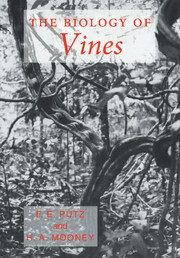Book contents
- Frontmatter
- Contents
- List of contributors
- Foreword
- Preface
- Acknowledgements
- I INTRODUCTION
- II CLIMBING MECHANICS AND STEM FORM
- III VINE PHYSIOLOGY AND DEVELOPMENT
- IV COMMUNITY ECOLOGY OF VINES
- V ECONOMIC IMPORTANCE OF VINES
- 16 The ethnobotany and economic botany of tropical vines
- 17 Biology, utilization, and silvicultural management of rattan palms
- 18 Silvicultural effects of lianas
- Taxonomic index
- General index
18 - Silvicultural effects of lianas
Published online by Cambridge University Press: 05 November 2011
- Frontmatter
- Contents
- List of contributors
- Foreword
- Preface
- Acknowledgements
- I INTRODUCTION
- II CLIMBING MECHANICS AND STEM FORM
- III VINE PHYSIOLOGY AND DEVELOPMENT
- IV COMMUNITY ECOLOGY OF VINES
- V ECONOMIC IMPORTANCE OF VINES
- 16 The ethnobotany and economic botany of tropical vines
- 17 Biology, utilization, and silvicultural management of rattan palms
- 18 Silvicultural effects of lianas
- Taxonomic index
- General index
Summary
Introduction
In forests managed for timber production, lianas can be a serious nuisance (e.g. Dawkins, 1958). Lianas rely on trees for mechanical support, often display their foliage above the leaves of their host trees, and root in more or less the same soil volumes as trees. It is not surprising, therefore, that lianas have repeatedly been reported to compete with trees for water, light, and nutrients. The deleterious effects of lianas on trees can include stem breakage and deformation, increased accessibility to herbivorous animals, and decreased growth rates. In this chapter I review evidence for the negative effects of lianas on trees, discuss the characteristics of lianas that may enhance their competitive ability, and outline silvicultural practices used to minimize the ill effects of lianas on trees. Beneficial effects of lianas on ecosystems, for example their roles in reducing soil erosion and contributing to the maintenance of animal diversity, are not considered because the focus of this chapter is on maximizing the production and quality of timber.
Tree stem deformations due to lianas
In the process of climbing up to and through forest canopies, lianas often damage the trees on which they rely for physical support. Trunk deformations are of particular concern to silviculturalists because trees with poor stem form are physically difficult to handle during logging and generally are not saleable other than as pulp wood. Furthermore, deformed trees are more susceptible to pathogens and breakage (e.g. Shigo, 1986).
- Type
- Chapter
- Information
- The Biology of Vines , pp. 493 - 502Publisher: Cambridge University PressPrint publication year: 1992
- 12
- Cited by



